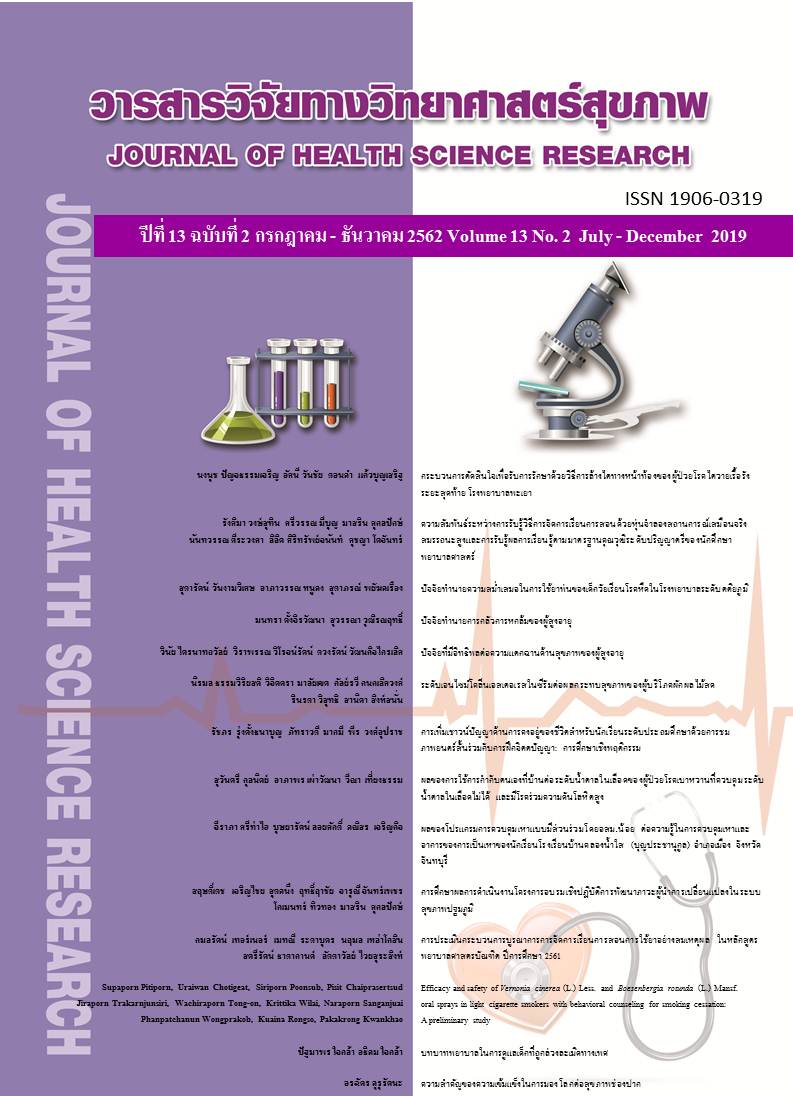ปัจจัยทำนายความสม่ำเสมอในการใช้ยาพ่นของเด็กวัยเรียนโรคหืด ในโรงพยาบาลระดับตติยภูมิ
Main Article Content
บทคัดย่อ
การศึกษาเชิงพรรณนานี้มีวัตถุประสงค์ เพื่อศึกษาความสม่ำเสมอในการใช้ยาพ่นของเด็กวัยเรียนโรคหืด และปัจจัยทำนายความสม่ำเสมอในการใช้ยาพ่นของเด็กวัยเรียนโรคหืด ได้แก่ ความรู้เกี่ยวกับโรคหืดของผู้ดูแล การมีส่วนร่วมในการจัดการโรคหืดของผู้ดูแล ความรู้เกี่ยวกับโรคหืดของเด็ก และทัศนคติต่อการใช้ยาพ่นของเด็ก กลุ่มตัวอย่างคือ เด็กวัยเรียน อายุ 8-12 ปี และผู้ดูแล 120 คู่ จากคลินิกภูมิแพ้ โรงพยาบาลระดับตติยภูมิ 2 แห่ง เลือกกลุ่มตัวอย่างเป็นแบบสะดวก เครื่องมือที่ใช้ในการวิจัย ประกอบด้วย แบบสอบถามความรู้เกี่ยวกับโรคหืดของผู้ดูแล การมีส่วนร่วมในการจัดการโรคหืดของผู้ดูแล ความรู้เกี่ยวกับโรคหืดของเด็ก ทัศนคติต่อการใช้ยาพ่นของเด็ก และความสม่ำเสมอในการใช้ยาพ่นของเด็ก มีค่าความเชื่อมั่น เท่ากับ .71, .91, .70, .72 และ .73 ตามลำดับ วิเคราะห์ข้อมูลด้วยสถิติพรรณนา สัมประสิทธิ์สหสัมพันธ์แบบพอยซ์ไบซีเรียล และสถิติถดถอยโลจิสติกเชิงทวิ
ผลการวิจัยพบว่า เด็กวัยเรียนโรคหืดใช้ยาพ่นสม่ำเสมอร้อยละ 83.30 และปัจจัยที่สามารถทำนายความสม่ำเสมอในการใช้ยาพ่น คือ ทัศนคติต่อการใช้ยาพ่นของเด็ก (OR = 1.46, 95% CI: 1.18 – 1.79, p < .001) ปัจจัยทั้งสี่ปัจจัยสามารถอธิบายการผันแปรของความสม่ำเสมอในการใช้ยาพ่นของเด็กวัยเรียน โรคหืดได้ร้อยละ 75.00 (Nagelkerke R2 = 0.75, p < .05)
ข้อเสนอแนะ บุคลากรทางสุขภาพ ควรส่งเสริมทัศนคติเชิงบวกต่อการใช้ยาพ่นแก่เด็กวัยเรียน เพื่อสนับสนุนให้เด็กใช้ยาพ่นอย่างสม่ำเสมอ
Downloads
Article Details
บทความที่ได้รับการตีพิมพ์เป็นลิขสิทธิ์ของวิทยาลัยพยาบาลบรมราชชนนี จังหวัดนนทบุรี
ข้อความที่ปรากฏในบทความแต่ละเรื่องในวารสารวิชาการเล่มนี้เป็นความคิดเห็นส่วนตัวของผู้เขียนแต่ละท่านไม่เกี่ยวข้องกับวิทยาลัยพยาบาลบรมราชชนนี จังหวัดนนทบุรี และคณาจารย์ท่านอื่น ในวิทยาลัยฯ แต่อย่างใด ความรับผิดชอบองค์ประกอบทั้งหมดของบทความแต่ละเรื่องเป็นของผู้เขียนแต่ละท่าน หากมีความผิดพลาดใด ๆ ผู้เขียนแต่ละท่านจะรับผิดชอบบทความของตนเองแต่ผู้เดียว
เอกสารอ้างอิง
2. Reserves medical statistics unit, Medical record division, Faculty of Medicine Siriraj hospital. Statistics report 2016. Bangkok: Mahidol University; 2017. (in Thai).
3. Tangpathomwong C, Nookong A, Senasuttipan W. Children and caregiver factors predicting asthma control of school aged children. Journal of Nursing and Health Care. 2016;34(2):67-76. (in Thai).
4. Dean BB, Calimlim BC, Sacco P, Aguilar D, Maykut R, Tinkelman D. Uncontrolled asthma: Assessing quality of life and productivity of children and their caregivers using a cross-sectional Internet-based survey. Health and Qual Life Outcomes. 2010;8(1): 96.
5. Bellin MH, Osteen P, Kub J, Bollinger ME, Tsoukleris M, Chaikind L, et al. Stress and quality of life in urban caregivers of children with poorly controlled asthma: A longitudinal analysis. J Pediatr Health Care. 2015;29(6) :536-46.
6. Thai Asthma Council. Controversial issues in asthma 2016 [Internet]. 2016 [cited 2018 Mar 11]; Available from: https://www.slide share .net/ UtaiSukvi watsiri kul/controversial- in-asthma-20-22-mar-2016-final. (in Thai).
7. GINA guideline. Global strategy for asthma management and prevention. [Internet]. 2018 [cited 2019 Mar 11]; Available from: https://guidelines.gov/ content.aspx?id=37283.
8. Sonney J, Insel KC, Segrin C, Gerald LB, Ki Moore IM. Association of asthma illness representations and reported controller medication adherence among school-aged children and their parents. J Pediatr Health Care. 2017;31(6):703-12.
9. Klok T, Kaptein AA, Duiverman EJ, Brand PL.Long-term adherence to inhaled corticosteroids in children with asthma: Observational study. Respir Med. 2015;109(9) :1114-9.
10. Elkout H, Helms PJ, Simpson CR, McLay JS. Adequate levels of adherence with controller medication is associated with increased use of rescue medication in asthmatic children. PLOS ONE. 2012;7(6) :e39130.
11. Finkelstein JA, Lozano P, Farber HJ, Miroshnik I, Lieu TA. Underuse of controller medications among medicaid-insured children with asthma. Arch Pediatr Adolesc Med. 2009;156(6):562-7.
12. Wijga AH, Zuidgeest MGP, Kerkhof M, Koppelman GH, Smit HA, Jongste JC. Guideline-recommended use of asthma medication by children is associated with parental information and knowledge: the PIAMA birth cohort. Pharmacoepidemiol Drug Saf. 2014;23(4):406-10.
13. Wysocki T, Gavin L. Psychometric properties of a new measure of fathers' involvement in the management of pediatric chronic diseases. J Pediatric Psychol. 2004;29(3):231-40.
14. Koster ES, Philbert D, Winters NA, Bouvy ML. Adolescents’ inhaled corticosteroid adherence: the importance of treatment perceptions and medication knowledge. J Asthma Allergy. 2015;52(4):431-6.
15. Ceemaharsujakuen J. The relationships among asthma knowledge, beliefs about medication, asthma severity and medication adherence. [Thesis]. Bangkok: Mahidol University; 2015. (in Thai).
16. Vanichbuncha K. Advanced statistical analysis with SPSS for windows 7thed. Bangkok: Thammasan; 2009. (in Thai).
17. Al-Motlaq M, Sellick K. Development and validation of an asthma knowledge test for children 8–10 years of age. Child Care Health Dev. 2011;37(1):123-8.
18. Friedman D, Masek B, Barreto E, Baer L, Lapey A, Budge E, et al. Fathers and Asthma Care: Paternal involvement, beliefs, and management skills. J pediatr psychol. 2015;40(8):768-80.
19. Cohen JL, Mann DM, Wisnivesky JP, Horne R, Leventhal H, Musumeci-Szabo TJ, et al. Assessing the validity of self-reported medication adherence among inner-city asthmatic adults: The medication adherence report scale for asthma. Ann Allergy Asthma Immunol. 2009;103(4):325-31.
20. Ajzen I. Attitude, personality, and behavior. Illinois: Dorsey; 1988.
21. Nitirungruang P, Ua-Kit N. Factors predicting allergic symptoms preventive behavior among school-age children. Journal of public health nursing. 2013;27(2):23-33. (in Thai)
22. Chuntika J, Pongsaranankul Y. Growth and child development. Musiksukont S, Tilokskulchai F, Lertwongpaopun W, Preungvate O, Sangperm P, Payakkaraung S. Pediatric Nursing. 4thed. Bangkok: Mahidol University; 2015. (in Thai).


